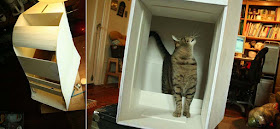Julälsningar to my Scandinavian readers. That's Swedish for Season’s Greetings. The Dälahast (a.k.a Dala Horse, or Dalecarlian Horse) is a wooden children’s toy traditionally carved over cold long winters in the province of Dalarna. It has become the unofficial symbol of Sweden.
Several types of Dälahast are distinguished by locality.
The most typical carvings are painted bright red with graphic details in
white, green, yellow and blue. They stand anywhere from 6" to 36" tall, but the largest Dälahast in the world can be found in Avesta Municipality in Sweden. This concrete monument looms above trees at over 42'.
The Dälahast that I made for Tretorn Shoes is 6'3". Henrik is made entirely of Papier Machier, this Swedish steed graces their store front in Soho eagerly greeting Holiday shoppers.
The decorative method of applying two colors on the same brush is called rosemaling — a skilled freehand craft. Rosemal patterns often adorn their woodwork and ceramics. I’m a very big fan of Scandinavian design — traditional and modern. I especially am fond of the graphic patterns and motifs found in their knitting, and of course the organic nature of their furniture — all of these borne of Scandinavian innovation.
But how does one make something so large in a small Brooklyn living room? I mapped out the structure and created a hollow modular pieces. Each piece assembles together precisely.
My assistant, Phillip the Cat, inspected the interior for structural
flaws — he approved. The interior of the head and body is a small
engineering marvel, built with interior struts to hold its shape and
support its weight. The head and
legs attach to the body by mortise and tenon.
The entire horse is covered in four to six layers of paper and glue, primed with two coats of gesso, two
coats of orange under coat, and a red top coat. These layers of paint
give the Dälahast the deepest red. Each piece is decorated separately.
In 1891 Tretorn was founded by Henry Dunker in Helsingborg, Sweden. Although this company is known for fine tennis products, rubber soled boots and sneakers, the company originally produced high quality rubber for tires. Tretorn’s long history of rubber production evolved from tires to tennis balls in 1902 and, later, a complete line of rubber soled sport shoes in 1934. I particularly love their rubber boots. They are exemplary of Swedish design and innovation.
I have to say I’m very proud of Henrik, it was hard to set him free. He’s a handsome fellow, no? Swing by Tretorn if you’re in Soho and say hej to Henrik.
Tretorn
150 Spring St (bet W B'way & Wooster)
New York, NY 10012









Absolutely beautiful! The proportions, colors and patterns are so right. You really are a crafty primate.
ReplyDeleteThanks Janice H!
ReplyDelete